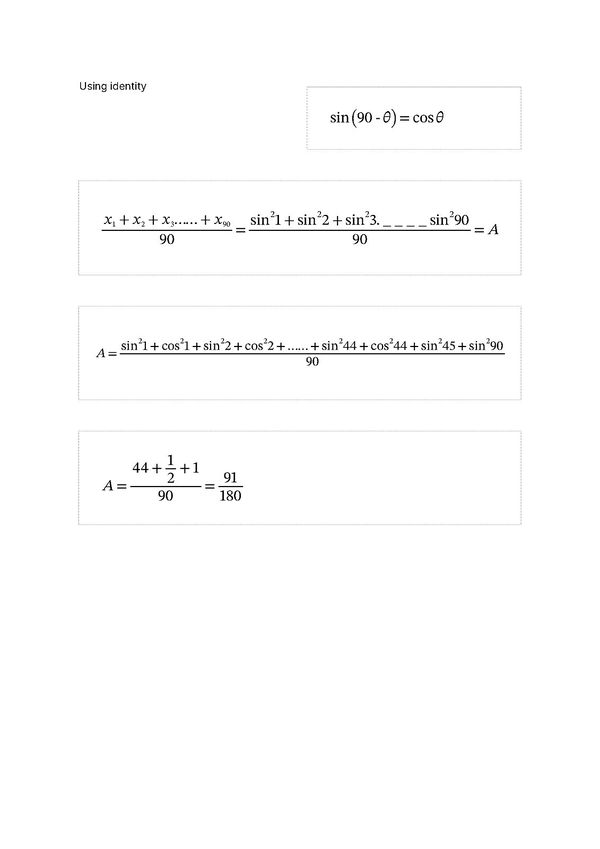Difference between revisions of "2024 AMC 12B Problems/Problem 11"
Sourodeepdeb (talk | contribs) (→Solution 5 (Calculus)) |
Sourodeepdeb (talk | contribs) (→Solution 5 (Calculus)) |
||
| Line 54: | Line 54: | ||
| − | ==Solution 5 ( | + | ==Solution 5 (Integral Approximation)== |
Let \( f(n) = \sin^2(n^\circ) \) | Let \( f(n) = \sin^2(n^\circ) \) | ||
Revision as of 22:31, 2 August 2025
Contents
Problem
Let ![]() . What is the mean of
. What is the mean of ![]() ?
?
![]()
Solution 1
Add up ![]() with
with ![]() ,
, ![]() with
with ![]() , and
, and ![]() with
with ![]() . Notice
. Notice
![]() by the Pythagorean identity. Since we can pair up
by the Pythagorean identity. Since we can pair up ![]() with
with ![]() and keep going until
and keep going until ![]() with
with ![]() , we get
, we get
![\[x_1+x_2+\dots+x_{90}=44+x_{45}+x_{90}=44+\left(\frac{\sqrt{2}}{2}\right)^2+1^2=\frac{91}{2}\]](http://latex.artofproblemsolving.com/8/6/d/86d02b9f4fe65d5c9a788a85a28aea71f372c702.png) Hence the mean is
Hence the mean is ![]()
~kafuu_chino
Solution 2
We can add a term ![]() into the list, and the total sum of the terms won't be affected since
into the list, and the total sum of the terms won't be affected since ![]() . Once
. Once ![]() is added into the list, the average of the
is added into the list, the average of the ![]() terms is clearly
terms is clearly ![]() . Hence the total sum of the terms is
. Hence the total sum of the terms is ![]() . To get the average of the original
. To get the average of the original ![]() , we merely divide by
, we merely divide by ![]() to get
to get ![]() . Hence the mean is
. Hence the mean is ![]()
This method is called constructing a variable (although most of you already know).
~tsun26, ShortPeopleFartalot
Solution 3 (Inductive Reasoning)
If we use radians to rewrite the question, we have: ![]() . Notice that
. Notice that ![]() have no specialty beyond any other integers, so we can use some inductive processes.
have no specialty beyond any other integers, so we can use some inductive processes.
If we change ![]() to
to ![]() :
: ![\[\frac{\sin^2\left(\frac{\pi}{4}\right)+\sin^2\left(\frac{2\pi}{4}\right)}{2}=\frac{\left(\frac{1}{\sqrt{2}}\right)^2+\left(1\right)^2}{2}=\frac{\frac{1}{2}+1}{2}=\frac{3}{4}\,.\]](http://latex.artofproblemsolving.com/1/8/8/1889ffab39fb8a79ac3fb5a862b724916f6d1a3d.png)
If we change ![]() to
to ![]() :
: ![\[\frac{\sin^2\left(\frac{\pi}{6}\right)+\sin^2\left(\frac{2\pi}{6}\right)+\sin^2\left(\frac{3\pi}{6}\right)}{3}=\frac{\left(\frac{1}{2}\right)^2+\left(\frac{\sqrt{3}}{2}\right)^2+\left(1\right)^2}{3}=\frac{\frac{1}{4}+\frac{3}{4}+1}{3}=\frac{2}{3}=\frac{4}{6}\,.\]](http://latex.artofproblemsolving.com/5/f/6/5f607bdeabf45870c0c46b705d4992d2da304604.png)
By intuition, although not rigorous at all, we can guess out the solution if we change ![]() into
into ![]() , we get
, we get ![]() . Thus, if we plug in
. Thus, if we plug in ![]() , we get
, we get ![]()
~Prof. Joker
Solution 4
~Kathan
Solution 4
Note that ![]() . We want to determine
. We want to determine  .
.

Graphing ![]() , we can pair
, we can pair ![]() and so on. We are left with
and so on. We are left with ![]() .
.
Our answer is ![]()
~vinyx
Solution 5 (Integral Approximation)
Let \( f(n) = \sin^2(n^\circ) \)
The function \( f(n) = \sin^2(n) \) is continuous for all real values of \( n \). We want to find the average value of \( f(n) \) over the interval: ![]()
While there are 90 discrete terms meaning \( f(n)\) isn't actually continuous, the interval isn't very large and 90 is a lot of values so calculating the average over EVERY term in the interval will be very close to calculating the average over 90 terms, so we can instead calculate the average value from ![]() to
to ![]()
The average value of \( f(n) \) is 
We can solve this integral using the power-reduction identity: ![]()


![$= \frac{180}{89\pi} \left[ \left(\frac{\pi}{4} - 0\right) - \left(\frac{\pi}{360} - \frac{\sin\left(\frac{\pi}{90}\right)}{4}\right) \right]$](http://latex.artofproblemsolving.com/3/3/4/334d1f9d1dfc73d8ed2d87bbb3c81ae2343bd1d0.png)

The taylor series of ![]()
Because ![]() is a small angle, we can use a first-order taylor approximation and approximate
is a small angle, we can use a first-order taylor approximation and approximate ![]()
Hence, our result is ![]()
While ![]() isn't an option, it is greater than
isn't an option, it is greater than ![]() , and out of the given options, only
, and out of the given options, only ![]() is greater than
is greater than ![]() (We approximated
(We approximated ![]() with a first-order taylor approximation and calculated the average value over the interval instead of over 90 discrete values, but it's close enough to
with a first-order taylor approximation and calculated the average value over the interval instead of over 90 discrete values, but it's close enough to ![]() ).
).
So the answer is ![]()
-sourodeepdeb
Video Solution 1 by SpreadTheMathLove
https://www.youtube.com/watch?v=gJq7DhLNnZ4&t=0s
See also
| 2024 AMC 12B (Problems • Answer Key • Resources) | |
| Preceded by Problem 10 |
Followed by Problem 12 |
| 1 • 2 • 3 • 4 • 5 • 6 • 7 • 8 • 9 • 10 • 11 • 12 • 13 • 14 • 15 • 16 • 17 • 18 • 19 • 20 • 21 • 22 • 23 • 24 • 25 | |
| All AMC 12 Problems and Solutions | |
These problems are copyrighted © by the Mathematical Association of America, as part of the American Mathematics Competitions. ![]()










